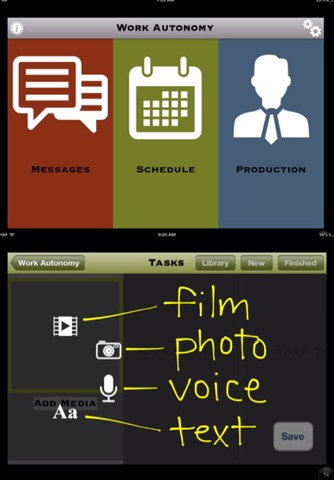
Work Autonomy provides higher levels of independence for people with disabilities in the work site allowing for fluency in three areas that traditionally challenge successful competitive placements: person-generated communication with coworkers and supervisors regardless of linguistic or cognitive skill, tracking task analysis and work schedules independently, and allowing access to concrete information about work expectations, production and dollars. People with disabilities, parents, teachers, SLPs, and Vocational Rehabilitation Specialists recommend Work Autonomy for people with Downs Syndrome, autism, cognitive disorders, intellectual and/or developmental disabilities, stroke and traumatic brain injury.
The design is focused on access for the user with a disability to program and track concrete information about their work life. All or any of three sections can be turned on and programmed for use: Messages, Schedules and Production. Sections allow for the capture of content using video, photo, text and/or voice to meet the preferences or communication and processing needs of the user.
Video can be used to capture gestures, ASL, specific actions, routes to locations, etc. Photos of people, places and things can capture the users actual experience, providing the most functional connection between the picture and what it represents. Voice and Text options can stand-alone or be used with pictures for labeling or captions.
All programmed information is stored in a library within the section captured and can be retrieved for repetitive use. Work Autonomy uses real photos and voice rather than black line drawings and automated voices typical in picture exchange communication systems (PECS) and other augmentative communication systems.
The Messages section allows the user with communication challenges to tell stories across environments and to communicate with customers and coworkers.
* Communication about, for or by the person is captured by the user.
* Like others, share stories between home and work about special events.
* Preprogram regular communication for use on the worksite.
* In the “External” section, capture others with messages, Ex) your family informing the employer of an upcoming vacation request.
The Schedule section allows the user with a disability to capture work tasks in the order to be completed, with the ability to break each task into smaller steps using video, photo, voice and/or text. Parameters measuring the job expectations are set using a visual timer, counter and/or clock.
* The schedule can be captured with the employer, who sets the expectations for performance. The job coach can be identified as the support to reach work goals.
* Tasks can be measured timing up, timing down, counting up, counting down and/or following a clock to match the flow of the jobsite and the measure of success.
* When starting the schedule the task chosen is displayed along with a time timer, counter and or working clock that represent the expectations set and work completed.
The Production section allows the user with a disability to see the measure of their work production in concrete terms, using a graph to track timed and/or counted elements of the job. Targets can be set on the graph by the employer to clarify work expectations. A second graph measuring earnings and lost wages is available to provide concrete information about work choices.
* Employers can communicate directly with their employee about work performance.
* Employees with disabilities have concrete information about work expectations.
* This information can be seen in day/week and month views.
* The graph can be emailed directly to the employer, coach, or guardian.
* Adaptive Switch Access
* Apple’s Volume Licensing for Education available
* Educational tutorials and support videos available on www.ableopps.com


